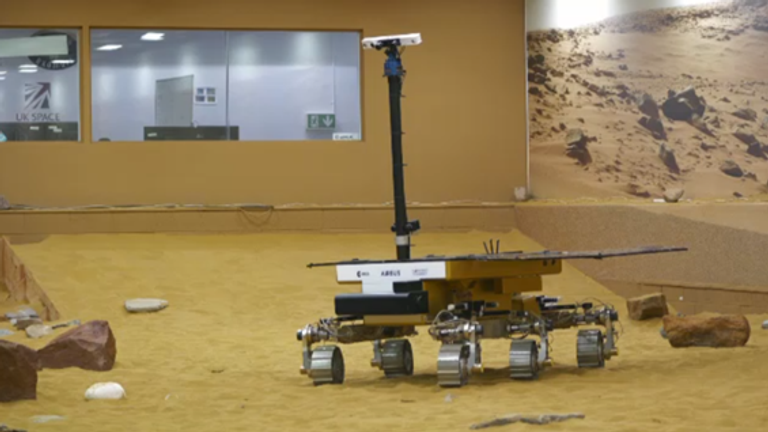A British-built Mars rover caught on Earth for the reason that begin of the battle in Ukraine could quickly be on its method after the UK House Company agreed to pay for its trip all the way down to the Purple Planet.
The European House Company’s Rosalind Franklin rover was presupposed to land on Mars in 2023.
However the rocket powered system designed to ferry the delicate rover all the way down to the planet’s floor was being constructed beneath contract by Russia‘s house company Roscosmos.
After the invasion of Ukraine, ESA cancelled the contract, leaving the Rosalind rover, designed to seek for indicators of previous life on Mars, stranded.
The £150m contract from the UK House Company for Airbus to switch the Russian touchdown system places the mission again on observe.
“We may unlock a number of the key questions that humanity is asking of itself,” mentioned Peter Kyle, Secretary of State for Science.
“If we may do this, and profit from a number of the outcomes and the innovation that may stream from it, then I feel it is a fairly good funding for Britain to have.”
It is excellent news for the Rosalind rover – a central a part of ESA’s ExoMars programme – as a result of it has been some of the delayed, and disrupted missions in house historical past.
Early plans noticed it launching in 2018.
However NASA, initially a companion within the enterprise, pulled out because of funding constraints leaving ESA member states having to make up the shortfall.
Completion of the lander was then delayed by COVID restrictions, then basically grounded when Russia was booted out of the mission.
‘Scary however thrilling’
Constructed by Airbus UK at its facility in Hertfordshire, it appeared for some time as if Stevenage was as near Mars because the Rosalind rover was going to get.
Now Airbus has the contract to construct the lander for the rover as effectively.
It is a increase for the UK house sector, however a fraught one.
The corporate has simply three years to finish the mission and neither Airbus, nor the UK has constructed a propulsion system for touchdown on one other planet earlier than.
Extra irritating nonetheless, the actual fact 60% of Mars missions finish in failure, many within the essential touchdown part.
Europe’s final Mars lander – a mission known as Schiaparelli designed to check the rover’s touchdown system – crash landed in 2016.
The UK’s final bid to land on Mars with the bin lid-sized Beagle 2 probe, shared the identical destiny.
“There’s plenty of effort all working collectively to verify we undergo every technical element, that that is sound and we are able to make it occur,” mentioned Caroline Rodier, ExoMars lander lead at Airbus.
“It’s scary, however it is rather thrilling.”
The Rosalind Franklin rover is designed to search for indicators of previous, and even current, life on Mars.
Named after the British scientist who helped uncover the construction of DNA, the rover carries with it an on-board laboratory to check rock and soil samples for chemical signatures of life.
NASA Mars rover missions have aimed to do the identical, however Rosalind’s edge comes within the type of a drill able to penetrating two metres into Martian soil, hopefully deep sufficient to seek out molecules that have not been degraded by the cruel radiation on the planet’s floor.
Having its all-important touchdown system constructed beneath the identical roof in Stevenage as Rosalind herself, is that if something, a confidence increase, in accordance with the person who led the rover’s growth.
“Earlier than we have been constructing our rover and needed to depend on others to get it down safely. Whereas now we’re enjoying a giant half in that lander platform,” mentioned Chris Draper, head of Mars programmes at Airbus.
“Understanding these guys in addition to I do, I am happy we’re a part of it.”
Learn extra from Sky Information:
Analysis – JD Vance felt the cold in Greenland
Clocks go forward this weekend
Since their earlier departure NASA has since rejoined the partnership to offer the rocket that may carry the rover to Mars.
It is because of launch in 2028 and if all goes to plan, Rosalind Franklin may very well be drilling into the floor of Mars in search of proof of life by late 2030.




















